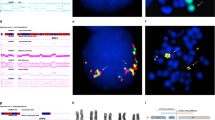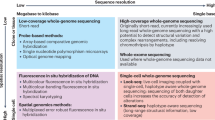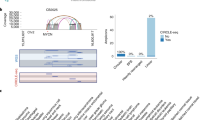Abstract
Homozygous deletions of human chromosome 9p21 occur frequently in malignant cell lines, and are also common in primary gliomas, lung cancers, and leukemias. Moving from the centromere to the telomere, this complex region encodes the tumor suppressor genes p15INK4B (CDKN2B), p14ARF, p16INK4A (CDKN2A), and the housekeeping gene methylthioadenosine phosphorylase (MTAP). However, not all chromosome 9p21 deletions in tumors include these tumor suppressor genes. Here we describe the partial sequence and the exact localization of a new gene on chromosome 9p21 centromeric of p15INK4B, that formed an in frame fusion transcript with MTAP in a glioma xenograft, and that is homozygously deleted in various malignant cell lines. Northern blot revealed corresponding 1.5 kb transcript in non-deleted cell lines as well as in normal lymphocytes. Using a RNA master blot membrane including 50 different tissues, we could show that this new transcript is expressed in all tissues of the adult but not or only at very low levels in most of the fetal tissues tested. The expression pattern is similar to that of p16INK4A. The localization as well as the deletion pattern makes this transcript a candidate for a new tumor suppressor gene.
This is a preview of subscription content, access via your institution
Access options
Subscribe to this journal
Receive 50 print issues and online access
$259.00 per year
only $5.18 per issue
Buy this article
- Purchase on Springer Link
- Instant access to full article PDF
Prices may be subject to local taxes which are calculated during checkout







Similar content being viewed by others
References
An HX, Niederacher D, Picard F, van Roeyen C, Bender HG and Beckmann MW. . 1996 Genes Chromosomes Cancer 17: 14–20.
Balazs M, Carroll P, Kerschmann R, Sauter G and Waldman FM. . 1997 Genes Chromosomes Cancer 19: 84–89.
Batova A, Diccianni MB, Nobori T, Vu T, Yu J, Bridgeman L and Yu AL. . 1996 Blood 88: 3083–3090.
Cayuela JM, Gardie B and Sigaux F. . 1997 Blood 90: 3720–3726.
Chen ZH, Olopade OI and Savarese TM. . 1997 Mol. Pharmacol. 52: 903–911.
Dreyling MH, Roulston D, Bohlander SK, Vardiman J and Olopade OI. . 1998 Genes Chromosomes Cancer 22: 72–78.
Farrell WE, Simpson DJ, Bicknell JE, Talbot AJ, Bates AS and Clayton RN. . 1997 Cancer Res. 57: 2703–2709.
Flores JF, Walker GJ, Glendening JM, Haluska FG, Castresana JS, Rubio MP, Pastorfide GC, Boyer LA, Kao WH, Bulyk ML, Barnhill RL, Hayward NK, Housman DE and Fountain JW. . 1996 Cancer Res. 56: 5023–5032.
Gonzalez MV, Pello MF, Lopez-Larrea C, Suarez C, Menendez MJ and Coto E. . 1997 J. Clin. Pathol. 50: 509–512.
Habuchi T, Devlin J, Elder PA and Knowles MA. . 1995 Oncogene 11: 1671–1674.
Hatta Y, Hirama T, Miller CW, Yamada Y, Tomonaga M and Koeffler HP. . 1995 Blood 85: 2699–2704.
Hori Y, Hori H, Yamada Y, Carrera CJ, Tomonaga M, Kamihira S, Carson DA and Nobori T. . 1998 Int. J. Cancer 75: 51–56.
Keen AJ and Knowles MA. . 1994 Oncogene 9: 2083–2088.
Kim SK, Ro JY, Kemp BL, Lee JS, Kwon TJ, Fong KM, Sekido Y, Minna JD, Hong WK and Mao L. . 1997 Cancer Res. 57: 400–403.
Kratzke RA, Otterson GA, Lincoln CE, Ewing S, Oie H, Geradts J and Kaye FJ. . 1995 J. Natl. Cancer Inst. 87: 1870–1875.
Li YJ, Hoang-Xuan K, Delattre JY, Poisson M, Thomas G and Hamelin R. . 1995 Oncogene 11: 597–600.
Marshall B, Isidro G, Martins AG and Boavida MG. . 1997 Cancer Genet Cytogenet 96: 134–139.
Matsuura K, Shiga K, Yokoyama J, Saijo S, Miyagi T and Takasaka T. . 1998 Anticancer Res. 18: 453–458.
Moulton T, Samara G, Chung WY, Yuan L, Desai R, Sisti M, Bruce J and Tycko B. . 1995 Am. J. Pathol. 146: 613–619.
Nishikawa R, Furnari FB, Lin H, Arap W, Berger MS, Cavenee WK and Su Huang HJ. . 1995 Cancer Res. 55: 1941–1945.
Nobori T, Miura K, Wu DJ, Lois A, Takabayashi K and Carson DA. . 1994 Nature 368: 753–756.
Okami K, Cairns P, Westra WH, Linn JF, Ahrendt SA, Wu L, Sidransky D and Jen J. . 1997 Int. J. Cancer 74: 588–592.
Olopade OI, Jenkins RB, Ransom DT, Malik K, Pomykala H, Nobori T, Cowan JM, Rowley JD and Diaz MO. . 1992 Cancer Res. 52: 2523–2529.
Orlow I, Lacombe L, Hannon GJ, Serrano M, Pellicer I, Dalbagni G, Reuter VE, Zhang ZF, Beach D and Cordon-Cardo C. . 1995 J. Natl. Cancer Inst. 87: 1524–1529.
Perry A, Nobori T, Ru N, Anderl K, Borell TJ, Mohapatra G, Feuerstein BG, Jenkins RB and Carson DA. . 1997 J. Neuropathol. Exp. Neurol. 56: 999–1008.
Puig S, Ruiz A, Lazaro C, Castel T, Lynch M, Palou J, Vilalta A, Weissenbach J, Mascaro JM and Estivill X. . 1995 Am. J. Hum. Genet. 57: 395–402.
Ruiz A, Puig S, Lynch M, Castel T and Estivill X. . 1998 Int. J. Cancer 76: 312–316.
Schmid M, Malicki D, Nobori T, Rosenbach MD, Campbell K, Carson DA and Carrera CJ. . 1998 Oncogene 17: 2669–2675.
Stadler WM and Olopade OI. . 1996 Urol. Res. 24: 239–244.
Tran PT, Hori H, Hori Y, Okumura K, Kagotani K, Taguchi H, Carson DA and Nobori T. . 1997 Gene 186: 263–269.
Waber P, Dlugosz S, Cheng QC, Truelson J and Nisen PD. . 1997 Oncogene 15: 1699–1704.
Wiest JS, Franklin WA, Otstot JT, Forbey K, Varella-Garcia M, Rao K, Drabkin H, Gemmill R, Ahrent S, Sidransky D, Saccomanno G, Fountain JW and Anderson MW. . 1997 Cancer Res. 57: 1–6.
Yamada Y, Hatta Y, Murata K, Sugawara K, Ikeda S, Mine M, Maeda T, Hirakata Y, Kamihira S, Tsukasaki K, Ogawa S, Hirai H, Hoeffler HP and Tomonaga M. . 1997 J. Clin. Oncol. 15: 1778–1785.
Acknowledgements
This work was supported in part by grant CA6976 from the National Cancer Institute; by grant DHP164 from the American Cancer Society and by grant 10-1636 Schm-2 from the Deutsche Krebshilfe. Mathias Schmid is a recipient of a postdoctoral fellowship from the Deutsche Krebshilfe.
Author information
Authors and Affiliations
Rights and permissions
About this article
Cite this article
Schmid, M., Sen, M., Rosenbach, M. et al. A methylthioadenosine phosphorylase (MTAP) fusion transcript identifies a new gene on chromosome 9p21 that is frequently deleted in cancer. Oncogene 19, 5747–5754 (2000). https://doi.org/10.1038/sj.onc.1203942
Received:
Revised:
Accepted:
Published:
Issue Date:
DOI: https://doi.org/10.1038/sj.onc.1203942



